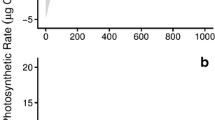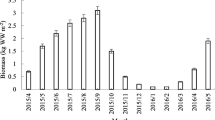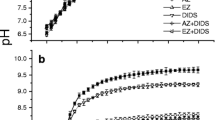Abstract
The Yellow Sea in China has experienced annual large-scale green tides since 2007. Ulva prolifera, the dominant causative species, originating from Pyropia yezoensis aquaculture rafts, experiences periodic tidal emersion in the intertidal nursery. It was proposed that physiological adaptations of U. prolifera may enable it to survive the harsh intertidal environment and contribute to subsequent blooms. In this paper, we measured the responses of photosynthesis and nitrogen assimilation of U. prolifera during desiccation of 0–6 h and subsequent rehydration for 0–24 h. The results suggested that both PSII photosynthesis and nitrogen assimilation were significantly reduced at the onset of desiccation. These reductions were reflected by decreases in the maximum quantum yield (F v/F m), effective photochemical quantum yield (YII), maximal electron transport rate (ETRmax), light utilization efficiency (α), NO3-N and NH4-N uptake rates, tissue nitrogen concentration (TN), and nitrate reductase activity (NRA). Desiccation temporarily lowered PSII photosynthesis, but rates recovered after algae were submerged for 24 h. Assimilation of nitrogen was also reduced during exposure to air. Although both NO3-N and NH4-N uptake rate recovered within 12 h upon rehydration, TN and NRA were not completed within 24 h. U. prolifera therefore appears well adapted to survive prolonged periods of desiccation, as it experiences growing in Pyropia farms along the Chinese Jiangsu coast. These traits, along with its ability to grow fast, may explain its success and one of the mechanisms behind the formation of the extreme blooms in the Yellow Sea.




Similar content being viewed by others
References
Berges JA, Franklin DJ, Harrison PJ (2001) Evolution of an artificial seawater medium: improvements in enriched seawater, artificial water over the last two decades. J Phycol 37:1138–1145
Cabello-Pasini A, Macías-Carranza V, Abdala R, Korbee N, Figueroa FL (2011) Effect of nitrate concentration and UVR on photosynthesis, respiration, nitrate reductase activity, and phenolic compounds in Ulva rigida (Chlorophyta). J Appl Phycol 23:363–369
Contreras-Porcia L, Callejas S, Thomas D, Sordet C, Pohnert G, Contreras A, Lafuente A, Flores-Molina MR, Correa JA (2012) Seaweeds early development: detrimental effects of desiccation and attenuation by algal extracts. Planta 235:337–348
Corzo A, Niell FX (1992) Inorganic nitrogen metabolism in Ulva rigida illuminated with blue light. Mar Biol 112:223–228
Dong MT, Zhang XW, Zou J, Ye NH, Xu D, Mou SL, Liang CW, Wang WQ (2012) Identification and expression analysis of the gene lhcSR associated with adaptation to light and low temperature stress in the green tide forming alga Ulva prolifera. Mar Biol Res 8:746–755
Fan X, Xu D, Wang YT, Zhang XW, Cao SN, Mou SL, Ye NH (2014) The effect of nutrient concentrations, nutrient ratios and temperature on photosynthesis and nutrient uptake by Ulva prolifera: implications for the explosion in green tides. J Appl Phycol 26:527–544
Gao S, Wang GC (2012) The enhancement of cyclic electron flow around photosystem I improves the recovery of severely desiccated Porphyra yezoensis (Bangiales, Rhodophyta). J Exp Bot doi:10.1093/jxb/ers082
Gao S, Shen SD, Wang GC, Niu JF, Lin AP, Pan GH (2011) PSI-driven cyclic electron flow allows intertidal macro-algae Ulva sp. (Chlorophyta) to survive in desiccated conditions. Plant Cell Physiol 52:885–893
Gao S, Zheng ZB, Gu WH, Xie XJ, Huan L, Pan GH, Wang GC (2014a) Photosystem I shows a higher tolerance to sorbitol-induced osmotic stress than photosystem II in the intertidal macro-algae Ulva prolifera (Chlorophyta). Physiol Plantarum 152:380–388
Gao ZQ, Xu D, Meng CX, Zhang XW, Wang YT, Li DM, Zou J, Zhuang ZM, Ye NH (2014b) The green tide-forming macroalga Ulva linza outcompetes the red macroalga Gracilaria lemaneiformis via allelopathy and fast nutrients uptake. Aquat Ecol 48:53–62
Henley WJ, Lindley ST, Levavasseur G, Osmond CB, Ramus J (1992) Photosynthetic response of Ulva rotundata to light and temperature during emersion on an intertidal sand flat. Oecologia 89:516–523
Holzinger A, Karsten U (2013) Desiccation stress and tolerance in green algae: consequences for ultrastructure, physiological and molecular mechanisms. Front Plant Sci 4:327
Hurd CL, Dring MJ (1991) Desiccation and phosphate uptake by intertidal fucoid algae in relation to zonation. Brit Phycol J 26:327–333
Karsten U, Holzinger A (2012) Light, temperature, and desiccation effects on photosynthetic activity, and drought-induced ultrastructural changes in the green alga Klebsormidium dissectum (Streptophyta) from a high alpine soil crust. Microbial Ecol 63:51–63
Kawamitsu Y, Driscoll T, Boyer JS (2000) Photosynthesis during desiccation in an intertidal alga and a land plant. Plant Cell Physiol 41:344–353
Kim JK, Kraemer GP, Yarish C (2008) Physiological activity of Porphyra in relation to eulittoral zonation. J Exp Mar Biol Ecol 365:75–85
Kim JK, Kraemer GP, Yarish C (2009) Research note: comparison of growth and nitrate uptake by New England Porphyra species from different tidal elevations in relation to desiccation. Phycol Res 57:152–157
Kuwae T, Kibe E, Nakamura Y (2003) Effect of emersion and immersion on the porewater nutrient dynamics of an intertidal sandflat in Tokyo Bay. Estuar Coast Shelf Sci 57:929–940
Lin HZ, Jiang P, Zhang JX, Wang JF, Qin S, Sun S (2011) Genetic and marine cyclonic eddy analyses on the largest macroalgal bloom in the world. Environ Sci Technol 45:5996–6002
Liu F, Pang SJ (2010) Stress tolerance and antioxidant enzymatic activities in the metabolisms of the reactive oxygen species in two intertidal red algae Grateloupia turuturu and Palmaria palmata. J Exp Mar Biol Ecol 382:82–87
Liu D, Keesing JK, Xing QG, Shi P (2009) World’s largest macroalgal bloom caused by expansion of seaweed aquaculture in China. Mar Pollut Bull 58:888–895
Liu DY, Keesing JK, He PM, Wang ZL, Shi YJ, Wang YJ (2013) The world’s largest macroalgal bloom in the Yellow Sea, China: formation and implications. Estuar Coast Shelf Sci 129:2–10
Luo MB, Liu F, Xu ZL (2012) Growth and nutrient uptake capacity of two co-occurring species, Ulva prolifera and Ulva linza. Aquat Bot 100:18–24
Martins I, Marques JC (2002) A model for the growth of opportunistic macroalgae (Enteromorpha sp.) in tidal estuaries. Estuar Coast Shelf Sci 55:247–257
Niwa K, Harada K (2013) Physiological responses to nitrogen deficiency and resupply in different blade portions of Pyropia yezoensis f. narawaensis (Bangiales, Rhodophyta). J Exp Mar Biol Ecol 439:113–118
Pang SJ, Liu F, Shan TF, Xu N, Zhang ZH, Gao SQ, Chopin T, Sun S (2010) Tracking the algal origin of the Ulva bloom in the Yellow Sea by a combination of molecular, morphological and physiological analyses. Mar Environ Res 69:207–215
Parages ML, Capasso JM, Niell FX, Jiménez C (2014) Responses of cyclic phosphorylation of MAPK-like proteins in intertidal macroalgae after environmental stress. J Plant Physiol 171:276–284
Proctor MCF, Smirnoff N (2000) Rapid recovery of photosystems on rewetting desiccation-tolerant mosses: chlorophyll fluorescence and inhibitor experiments. J Exp Bot 51:1695–1704
Runcie JW, Ritchie RJ, Larkum AWD (2003) Uptake kinetics and assimilation of inorganic nitrogen by Catenella nipae and Ulva lactuca. Aquat Bot 76:155–174
Runcie JW, Ritchie RJ, Larkum AWD (2004) Uptake kinetics and assimilation of phosphorus by Catenella nipae and Ulva lactuca can be used to indicate ambient phosphate availability. J Appl Phycol 16:181–194
Sun S, Wang F, Li C, Qin S, Zhou M, Ding L, Pang S, Duan D, Wang G, Yin B, Yu R, Jiang P, Liu Z, Zhang G, Fei X, Zhou M (2008) Emerging challenges: massive green algae blooms in the Yellow Sea. Nat Precedings 2266:1–5
Sven B, Eshel A (1983) Photosynthesis of Ulva sp. I. Effects of desiccation when exposed to air. J Exp Mar Biol Ecol 70:91–97
Thomas TE, Harrison PJ, Turpin DH (1987a) Adaptations of Gracilaria pacifica (Rhodophyta) to nitrogen procurement at different intertidal locations. Mar Biol 93:569–580
Thomas TE, Turpin DH, Harrison PJ (1987b) Desiccation enhanced nitrogen uptake rates in intertidal seaweeds. Mar Biol 94:293–298
Wang WT (2013) Study on the distribution and enrichment of nutrients in the sea-surface microlayer of the East China Sea. Dissertation, Ocean University of China
Wang XH, Qiao F, Lu J, Gong F (2011) The turbidity maxima of the northern Jiangsu shoal-water in the Yellow Sea, China. Estuar Coast Shelf Sci 93:202–211
Wang DS, Xu D, Wang YT, Fan X, Nai HY, Wang WQ, Zhang XW, Mou SL, Guan Z (2015) Adaptation involved in nitrogen metabolism in sea ice alga Chlamydomonas sp. ICE-L to Antarctic extreme environments. J Appl Phycol 27:787–796
Wieters EA, Medrano A, Quiroga G (2013) Spatial variation in photosynthetic recovery of intertidal turf algae from acute UVB and temperature stress associated with low tides along the central coast of Chile. J Exp Mar Biol Ecol 449:340–348
Xie X, Gao S, Gu W, Pan G, Wang G (2013) Desiccation induces accumulations of antheraxanthin and zeaxanthin in intertidal macro-alga Ulva pertusa (Chlorophyta). PLoS ONE 8:e72929
Xu D, Gao ZQ, Zhang XW, Fan X, Wang YT, Li DM, Wang WQ, Zhuang ZM, Ye NH (2012) Allelopathic interactions between the opportunistic species Ulva prolifera and the native macroalga Gracilaria lichvoides. PLoS ONE 7:e33648
Xu JF, Zhang XW, Ye NH, Zheng Z, Mou SL, Dong MT, Xu D, Miao JL (2013) Activities of principal photosynthetic enzymes in green macroalga Ulva linza: functional implication of C4 pathway in CO2 assimilation. Sci China Life Sci 56:571–580
Ye NH, Zhang XW, Mao YZ, Liang CW, Xu D, Zou J, Zhuang ZM, Wang QY (2011) ‘Green tides’ are overwhelming the coastline of our blue planet: taking the world’s largest example. Ecol Res 26:477–485
Young E, Lavery P, Van Elven B, Dring M, Berges JA (2005) Nitrate reductase activity in macroalgae and its vertical distribution in macroalgal epiphytes of seagrasses. Mar Ecol Prog Ser 288:103–114
Zhang XW, Xu D, Mao YZ, Li YX, Xue SY, Zou J, Lian W, Liang CW, Zhuang ZM, Wang QY, Ye NH (2011) Settlement of vegetative fragments of Ulva prolifera confirmed as an important seed source for succession of a large-scale green tide bloom. Limnol Oceanogr 56:233–242
Acknowledgments
This work was supported by National Natural Science Foundation of China (41306179), Hi-Tech Research and Development Program (863) of China (2012AA052103).
Author information
Authors and Affiliations
Corresponding author
Additional information
Responsible Editor: K. Bischof.
Reviewed by undisclosed experts.
Rights and permissions
About this article
Cite this article
Xu, D., Zhang, X., Wang, Y. et al. Responses of photosynthesis and nitrogen assimilation in the green-tide macroalga Ulva prolifera to desiccation. Mar Biol 163, 9 (2016). https://doi.org/10.1007/s00227-015-2806-6
Received:
Accepted:
Published:
DOI: https://doi.org/10.1007/s00227-015-2806-6




